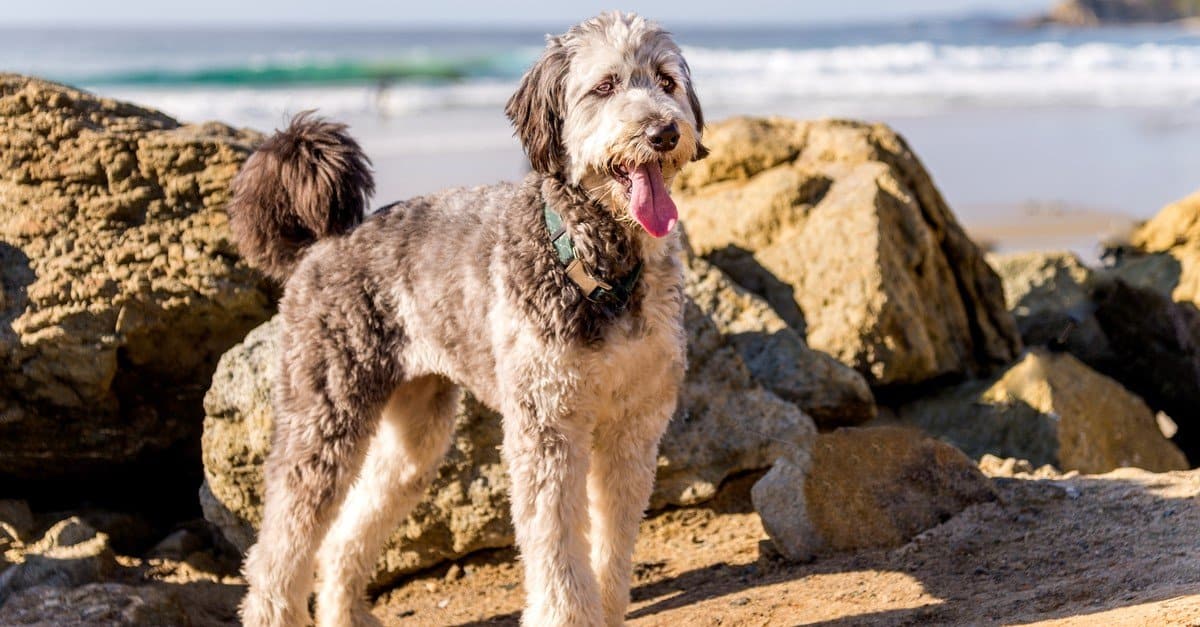Aussiedoodles, a crossbreed of Australian Shepherds and Poodles, are a popular family dog breed known for their friendly personality and intelligence. Their adaptability and sociable nature make them excellent companions for households with varied lifestyles. However, when it comes to considering whether Aussiedoodles can live outside, it is crucial to assess factors such as climate, the dog's coat, and its need for social interaction.

These dogs typically boast a coat that can vary from straight to curly, inheriting traits from both parent breeds. This can influence their ability to withstand certain weather conditions when living outdoors. Additionally, Aussiedoodles are active and require ample space to exercise and play, which outdoor living can provide. Yet, their social disposition means they thrive on interaction with their human families, which is an important consideration when evaluating their suitability for an outdoor lifestyle.
Careful consideration of an Aussiedoodles physical and emotional needs is essential before deciding on its living arrangements. While they may have the physical resilience to cope with outdoor conditions to some extent, they are fundamentally companion animals that may not be psychologically suited to living outside away from their family. The balance between their need for companionship and physical well-being is paramount in ensuring a healthy and happy life for an Aussiedoodle.

Origins and Breed History
Understanding the origins of the Aussiedoodle starts with recognizing its status as a hybrid dog, combining traits from its parent breeds, the Australian Shepherd and the Poodle. These combined attributes have helped the Aussiedoodle gain popularity as a designer dog.
Development of the Aussiedoodle
The Aussiedoodle, a crossbreed between an Australian Shepherd and a Poodle, emerged relatively recently. It resulted from deliberate breeding practices that commenced in the late 20th to early 21st century. The intention was to create a dog with the intelligence, good-natured temperament, and low-shedding coat. This hybrid was designed to inherit the best qualities of both its parent breeds for families, active individuals, and those with mild pet allergies.
Aussiedoodle Parent Breeds
Australian Shepherd:
- Origin: Despite the name, the Australian Shepherd was developed in the United States.
- Purpose: Originally bred for herding livestock.
- Characteristics: Intelligent, energetic, and versatile.
Poodle:
- Origin: Contrary to popular belief, the Poodle originated in Germany, but it's closely associated with France where it was popularized.
- Purpose: Bred initially as a water retriever.
- Characteristics: Highly intelligent, active, and also known for a hypoallergenic coat.
The amalgamation of these two breeds resulted in a ""designer dog"" well-suited for a variety of lifestyles. While not a breed known to thrive in outdoor living conditions, the Aussiedoodle's history as a mix of working backgrounds means they often possess the durability and intelligence passed down from their robust lineage.
Physical Characteristics
Aussiedoodles, a cross between Australian Shepherds and Poodles, have distinctive physical characteristics that are important to understand, particularly when considering their suitability for outdoor living.
Size and Weight
| Category | Measurement |
|---|---|
| Small | 10-15 inches; 10-20 pounds |
| Medium | 15-20 inches; 20-40 pounds |
| Large | 20-25 inches; 40-70 pounds |
Aussiedoodles come in three size categories: small, medium, and large, depending on which size Poodle is used in the breeding. Their weight corresponds with their size, ranging from as little as 10 pounds to up to 70 pounds for the largest variants.
Coat and Colors
The coat of an Aussiedoodle is usually soft and wavy to curly and can come in a variety of colors, including black, red, tan, and gray. Some common color patterns are:
- Solid
- Merle
- Parti
Their coats are often considered hypoallergenic due to the Poodle's influence, which means they typically shed less than many other breeds. However, the degree of shedding may vary from one Aussiedoodle to another.
Common Health Issues
Aussiedoodles are generally healthy, but they can inherit health issues common to their parent breeds. Some of these are:
- Hip Dysplasia: An irregular formation of the hip joint that can cause lameness or arthritis.
- Progressive Retinal Atrophy (PRA): A degenerative eye disorder that can lead to blindness.
- Cataracts: Opacity of the lens of the eye, which can lead to a decrease in vision.
- Epilepsy: A neurological disorder that can cause seizures.
Regular veterinary check-ups and a well-maintained diet are important for mitigating these potential health concerns.
Temperament and Behavior
Aussiedoodles are known for their blend of intelligence and friendly nature, which directly influences their behavior and adaptability in various environments.
Personality Traits
Aussiedoodles exhibit a range of personality traits that make them well-suited as companion animals. They are intelligent, capable of learning commands and tasks quickly. Their loyalty to their family is palpable, often creating a strong bond with their owners. These dogs are inherently friendly, which makes them excellent around children and other pets. However, due to their intelligence, they require regular mental stimulation to stay content and avoid developing destructive behaviors.
- Intelligence: Quick learners, receptive to training
- Loyalty: Deep bonding capability with owners
- Friendliness: Naturally sociable with people and pets
Behavioral Tendencies
The behavioral tendencies of Aussiedoodles are shaped by their mixed breed part Australian Shepherd, part Poodle both of which are breeds with high energy levels. Consequently, Aussiedoodles possess high energy and need ample exercise and playtime to maintain their mental and physical health. Without sufficient engagement, they may exhibit signs of anxiety, including separation anxiety. Regular socialization is crucial to help them develop into well-adjusted dogs.

- Energy Levels: High, requiring frequent exercise
- Playfulness: Enjoys playtimes, interactive games
- Exercise Needs: Daily exercise to dissipate energy
- Mental Stimulation: Essential to prevent boredom
- Anxiety: Potential for separation anxiety if left alone for too long
- Socialization: Necessary for behavioral development
Living Environment
The living environment significantly impacts the well-being of an Aussiedoodle. This breed requires a balanced environment that caters to its high energy levels and sensitivity to temperature extremes.
Adaptation to Outdoor Living
An Aussiedoodle can adapt to outdoor living if its needs for shelter, exercise, and attention are met. They need a sheltered space that protects them from elements such as extreme cold and heat which can lead to heat stroke or flu-like symptoms. Adequate shade and fresh water are imperative to prevent overheating and dehydration, particularly in warmer months.
- Shelter: Must be insulated against cold and provide ventilation for hot weather.
- Exercise area: A secure, fenced area for adequate physical activity.
- Attention: Regular human interaction to prevent behavioral issues.
Indoor Space Requirements
Indoor living spaces should accommodate an Aussiedoodle's needs for physical activity and mental stimulation. These dogs are highly energetic and require enough space indoors to move freely without feeling confined. A spacious indoor environment is essential for their well-being, helping to prevent anxiety and destructive behavior.
- Space: Open indoor areas are preferable.
- Stimulation: Access to toys and engagement with family members.
Environmental Sensitivity
Aussiedoodles have a sensitivity to the environment that owners should consider. They are susceptible to infections if they live in damp conditions or areas with poor sanitation. Preventive care, such as regular grooming and vet check-ups, is crucial to protect them from illnesses prevalent in outdoor settings.
- Cleanliness: Clean, dry areas to rest and play.
- Health: Regular health checks to prevent infections common in outdoor environments.
Training and Mental Stimulation
Training and mental stimulation are crucial for the well-being of an Aussiedoodle, as they are intelligent and thrive with engagement. Implementing consistent training techniques and providing mental enrichment activities can significantly contribute to their behavior and overall happiness.
Training Techniques
Positive Reinforcement: It is pivotal to use positive reinforcement when training an Aussiedoodle. This approach involves rewarding good behavior with treats, praise, or play to encourage repetition of the desired action.
- Consistency is key to success; training sessions should be regular and commands kept uniform.
- Socialization should begin early, exposing the dog to various people, pets, and environments to promote adaptable behavior.
- Training should include basic commands like sit, stay, come, and heel to ensure the dog's trainability and attention to the owner's directives.
Mental Enrichment Activities
Interactive Toys: Aussiedoodles require mental stimulation to prevent boredom and unwanted behaviors. Utilizing toys that require problem-solving can keep their minds active.
- Puzzle Feeders: Toys that dispense food as they solve a puzzle.
- Intelligent Games: Such as hide-and-seek or treasure hunts that involve finding hidden treats.
Engaging Exercises: Regular physical activities should incorporate exercises that also challenge their intelligence.
- Outdoor explorations, like hiking, can blend physical exercise with sensory experiences.
- Agility courses can provide physical activity while demanding concentration and problem-solving.
Time and Attention: An owner's involvement in their Aussiedoodle's mental engagement is indispensable.
- Owners should dedicate time to playing games that stimulate their pet's mind and fortify their bond.
- Regular training refreshers enhance cognitive functions and reinforce learned behaviors.
Care and Grooming Needs
Aussiedoodles are active dogs that require regular care and grooming to maintain their health and appearance. This section will detail their grooming routines and physical exercise needs.

Grooming Routines
Proper grooming is essential for Aussiedoodles due to their thick and often curly coats. Brushing should occur several times a week using a slicker brush or an undercoat rake to prevent mats and tangles. Routine checks and cleans of the ears to prevent infection are also important. Clippers or professional grooming services may be needed every 8-12 weeks to keep their fur at a manageable length. Regular tooth brushing and nail trimming are also part of their care regimen.
- Brushing Frequency: 2-3 times per week
- Grooming Schedule: Every 8-12 weeks
- Attention to Ears: Regular cleaning
Physical Exercise Requirements
Aussiedoodles require ample exercise to stay healthy and happy. Daily walks and playtime are a must. They thrive on activities that stimulate them physically and mentally. Engaging in games like fetch or agility training keeps them fit and harnesses their intelligence. Structured exercise sessions should be complemented with opportunities to run and play around in a safe, enclosed space, ensuring they get the exercise they need.
- Daily Walks: Minimum 30 minutes
- Running and Play: Encouraged in safe areas
- Games: Interactive play to stimulate mind and body
Feeding and Nutrition
Aussiedoodles require balanced nutrition tailored to their age, size, and activity level. Consistent feeding schedules and appropriate portions are crucial to maintain their optimal weight and health.
Dietary Considerations
Aussiedoodles thrive on high-quality dog food that caters to their energetic nature. It should contain a balanced mix of protein, carbohydrates, fats, vitamins, and minerals.
- Protein: Essential for muscle development, a minimum of 18% for adult dogs and 22% for puppies in dry food.
- Fats: Provide energy, with omega-3 and omega-6 fatty acids for coat health.
- Carbohydrates: Should be complex, like brown rice or sweet potatoes, for sustained energy.
- Vitamins and Minerals: Crucial for immune system support and overall health.
Adult dogs typically need lower calories compared to a growing puppy or a highly active adult. Treats should be given sparingly to avoid weight gain. Always ensure clean, fresh water is available.
Feeding Schedule
Consistency in feeding times helps regulate an Aussiedoodle's digestion and energy levels. The schedule varies with age:
- Puppies (<6 months): 3-4 meals per day.
- Adults: 2 meals per day.
| Age | Meals per Day | Notes |
|---|---|---|
| Puppies | 3-4 | Small, frequent meals recommended |
| Adults | 2 | Consistent times, morning and evening |
Monitor their weight and adjust food portions and feeding frequency accordingly. Visit a veterinarian for personalized advice on feeding and nutrition based on the dog's unique needs.
Integration with Family and Pets
Aussiedoodles tend to mesh well with families owing to their loyal and friendly nature. They thrive on attention and playtime, making them excellent companions for all family members.
Interaction with Children and Family
Aussiedoodles are generally good with kids, often showing patience and playfulness. Their energy levels match well with active children, and they typically form strong bonds with family members. It is important, however, for interactions to be supervised, especially with younger children, to ensure safe and positive experiences for both the dog and the children.
- Supervision: Always monitor playtime between Aussiedoodles and young children.
- Bonding: Encourage gentle play to foster a strong bond.
Social Mannerisms with Other Pets
These dogs usually display social mannerisms that make them suitable for homes with other pets. Proper introductions are key to fostering a peaceful coexistence. Aussiedoodles may view playtime with other family pets as enjoyable and stimulating, but as with any dog, individual temperaments can vary.
- Introductions: Gradual and controlled introductions to other pets.
- Playfulness: Encourage shared playtime to build camaraderie.
- Note: Individual personality traits can affect interactions.
Frequently Asked Questions
The following FAQs address common concerns and provide insight into the breed-specific needs of Aussiedoodles, particularly focusing on their adaptability to outdoor living.

- How well do Aussiedoodles tolerate cold weather?
- Aussiedoodles have a double-layer coat that can provide some insulation against the cold. However, they are not suited for extreme cold weather, and precautions should be taken when temperatures drop significantly.
- What is the recommended amount of exercise for an Aussiedoodle?
- An Aussiedoodle requires at least 30 to 60 minutes of exercise daily. This should include activities that stimulate both their body and mind due to their high energy and intelligence.
- Can Aussiedoodles adapt to apartment living?
- Aussiedoodles can adapt to apartment living if they are given sufficient exercise and mental stimulation. They are active indoors and require ample space to move around.
- What are common health concerns for Aussiedoodles?
- Common health concerns for Aussiedoodles include hip dysplasia, elbow dysplasia, epilepsy, and certain eye disorders. Regular check-ups and a healthy lifestyle can help mitigate these risks.
- How suitable are Aussiedoodles for outdoor activities like hiking?
- Aussiedoodles are excellent companions for outdoor activities such as hiking. They are energetic, agile, and enjoy being active, making them suitable for various terrains and endurance activities.
- At what size do Aussiedoodles typically max out in growth?
- Aussiedoodles typically reach their full size by 12 to 18 months of age. Their adult size usually ranges from 25 to 70 pounds, depending on whether they are a standard, miniature, or toy variation.




